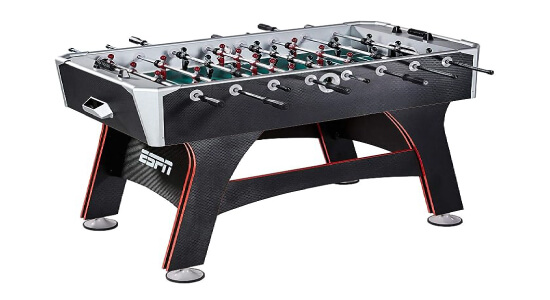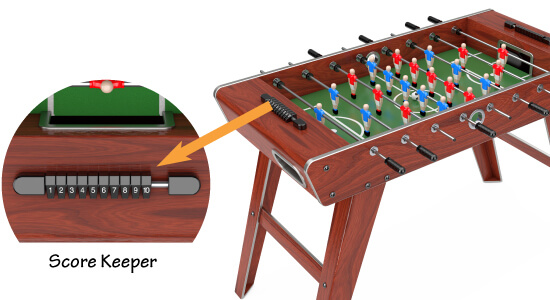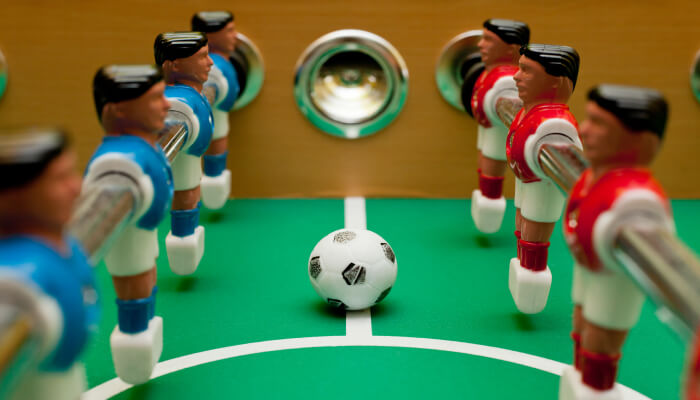The timeless game of foosball, known also as table soccer, has been a favorite pastime in bars, game rooms, and homes worldwide since its creation in the 1920s. Whether you’re a seasoned player or a novice, understanding the rules and strategies of foosball can significantly enhance your gaming experience. When you know the rules and techniques, you understand the game’s depth and can play smartly.
This comprehensive guide will take you through foosball’s history, rules, and techniques and provide advanced tips for beginners.
History of Foosball
Foosball, or table soccer, traces its origins back to the 1920s, when Harold Searles Thornton, an avid football fan from the United Kingdom, invented it. Inspired by a matchbox, Thornton’s design evolved and reached the U.S. by 1927.
The game’s popularity surged globally, adopting names like “Kicker” in Germany and “Baby Foot” in France. Post-WWII, Europe saw foosball’s therapeutic use for war veterans and the establishment of competitive leagues. In the U.S., servicemen introduced foosball in the 1960s, leading to its peak popularity in the 1970s. However, arcade games like Pac-Man overshadowed it by the 1980s.
The game quickly gained popularity, and today, foosball enjoys global appeal, with varied playing styles and table designs, symbolizing its rich history. The thrill of the game lies not only in its fast-paced action but also in the strategic thinking it demands.
The Objective of the Game
The primary goal of foosball is straightforward – to score more goals than your opponent. Using your team’s player figures to strike the ball into the opposing team’s goal is achieved. While it sounds simple, the game requires strategic thinking, swift reflexes, and excellent hand-eye coordination.
Equipment and Setup

You’ll need a foosball table that meets your requirements to play this game. Make sure to pick the best foosball table to experience the finest thrill of this indoor game. Halex, Barrington, Tornado, and ESPN, are some of the brands you can consider when buying a foosball table.
A standard foosball table has eight rods and 22 player figures, divided equally into two teams: one team is usually red and the other blue. The table is also equipped with a ball return system and scoring markers.
Now that we’ve covered the basics, let’s jump into foosball rules.
Foosball Rules
Just as in any sport, foosball has a set of basic rules that players must adhere to. The organization that oversees and establishes standardized rules for foosball is the International Table Soccer Federation (ITSF). The ITSF is responsible for promoting the sport of table soccer (foosball) globally and organizes international competitions. These rules determine the game’s start, the ball’s movement, scoring, and penalties.
Before you brief the rules, let’s take a quick look at the Do’s and Don’ts of Foosball!
Let’s break them down one by one.
Starting the Game
To start a game, a coin toss is typically conducted. The toss winner gets to choose between serving the ball first or picking which side of the table they want to play on. After the first game, teams switch sides, and the team that lost the previous game serves the ball.
Serving the Ball
The server is chosen based on the coin toss or the team that was last scored upon. Before serving, it’s considered good sportsmanship to tap the ball on the server side of the table as a signal that play is about to begin. The server can influence the roll of the ball before serving it. However, no part of the server’s hand should be in the playing area once the ball is in play.
Ball in Play
Once the ball is in play, it remains so until it is hit off the table, a dead ball is declared, a timeout is called, or a point is scored.
In foosball, a “dead ball” occurs when the ball is in a position where no player figure can touch or move it, often resting between two opposing figures or in an unreachable spot on the table.
A “time out” is a short break a player takes when the ball isn’t moving, often used for strategy or rest.
A ball entering a goal counts as a point, even if it bounces back out. No player may enter the play area while the ball is in play unless permitted by the opposing team.
Scoring
A goal can be scored with any player figure on any rod. It doesn’t matter which player figure last touched the ball; even if it’s accidentally knocked into one’s own goal, it counts as a point for the opposing team. If the ball enters the goal and bounces out, it still counts as a goal.

You can use the table’s default-score tracker or pen and paper to keep the score.
Time Limits
Specific time limits are set for ball possession to keep the foosball fast-paced and engaging. Players cannot hold the ball for over 15 seconds on any rod. Notably, the midfield bar has a shorter limit of just 10 seconds. Additionally, it’s worth mentioning that the goalie and defense rods are grouped, counting as a single bar for these time constraints. This ensures a fluid game flow and encourages strategic play.
Advanced Foosball Techniques and Strategies for Beginners
Now that you’re familiar with foosball’s basic rules let’s explore some advanced techniques and strategies to help beginners improve their game.
Shooting Techniques
There are several shooting techniques in foosball, the most common being the push, pull, and snake shots. These shots involve different ways of striking the ball with your player figures, creating various trajectories and speeds.
Defensive Strategies
Good defense is just as important as powerful offense in foosball. One common defensive strategy is to position your player figures in a staggered formation, making it harder for your opponent to find a clear path to your goal.
Conclusion
Understanding and following foosball rules is crucial for a fair and enjoyable game. While the game is easy, becoming a skilled player requires practice and a deep understanding of the rules and strategies. So, whether you’re playing a casual game with friends or participating in a tournament, remember to play fair, practice often, and above all, have fun!
